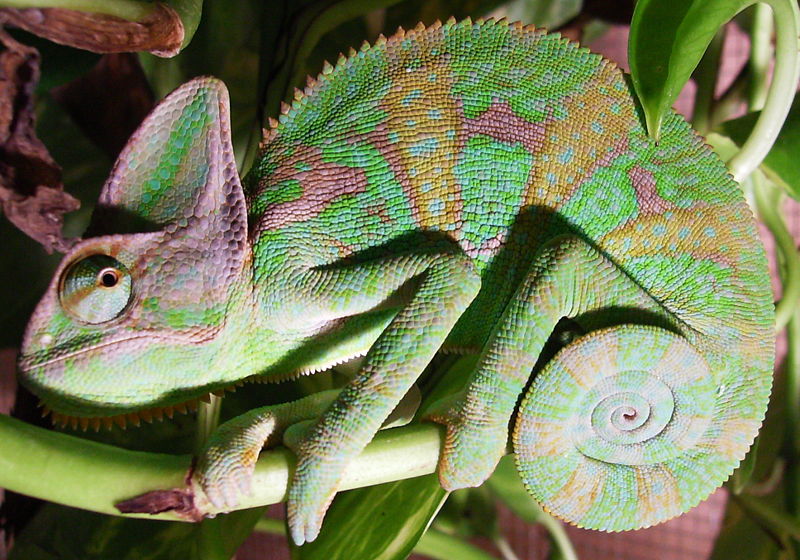- Veiled Chameleon
Taxobox
name = Veiled Chameleon
status = LR

image_width = 250px
image_caption = Veiled Chameleon
regnum =Animal ia
phylum = Chordata
classis = Reptilia
ordo =Squamata
subordo =Sauria
familia =Chamaeleonidae
genus = "Chamaeleo "
species = "C. calyptratus"
binomial = "Chamaeleo calyptratus"
binomial_authority = Duméril & Bibron, 1851The Veiled Chameleon ("Chamaeleo calyptratus"), is a largespecies ofchameleon found in themountain regions ofYemen andSaudi Arabia . It is also sometimes referred to as the Yemen Chameleon.The
male veiled chameleon is green in color and, depending on mood, this green will range from a bright lime green to a red olive drab. The green base color is marked with stripes and spots of yellow, brown, and blue. Non breedingfemale s and juvenile chameleons are generally a uniform green color with some white markings. Breeding and gravid females are a very dark green with blue and yellow spots. The prominence of these markings is dependent on several factors including health, mood, and temperature of the lizard.This species is sexually dimorphic, meaning it is possible to tell the gender of an individual by looking at physical traits. Aside from the previously mentioned color differences, adult male veiled chameleons are large
animal s. It is possible for them to reach an over all length of 24 inches (60 cm). Most specimens usually reach between 14 to 18 inches (35-45 cm). Females are smaller with the average overall length being just under 12 inches (30 cm). Males and females both have a decorative growth called a "casque" on their heads. The casque of a male chameleon is much taller than the female's. Males also have a spur on each hind leg that the females do not have.Like most chameleons, veiled chameleons are specialized
tree dwellers. They have a flattened body meant to mimic a leaf and feet specially designed for grasping limbs and branches. They have a prehensile tail that acts as a fifth appendage and aids in climbing. Theireye s work independently of one another allowing the chameleon to look in front of and behind itself at the same time. They have a long stickytongue that they use to capture theirinsect prey. Veiled chameleons are ambushpredators and are capable of lying still for very long periods of time waiting for an unsuspectinglocust to wander by.Veiled Chameleons are
omnivore s. While their main diet consists of insects, they will occasionally consume the leaves and blossoms of various plants. This is especially true in times ofdrought when water is scarce. Like all chameleons, veiled chameleons prefer to drink water that is in drops. They do not always recognize standing water and may dehydrate if that is their only source.Female veiled chameleons can produce up to 3 clutches of eggs a year. Each clutch may contain 20-70 eggs. The eggs usually take 6-9 months to hatch. All the eggs in the same clutch will hatch simultaneously, as long as they are incubated together. Female veiled chameleons will produce multiple clutches of eggs, with one male encounter and produce infertile eggs when there is no male, similar to chickens.
Veiled Chameleons are often kept in captivity due to the fact that they are relatively hardy when compared to other chameleon species often offered for sale.
If you are thinking about keeping a veiled chameleon as a pet here are some things you will need to consider:---they require a lot of maintenance, and are not recommended for first time lizard owners, so make sure you are able to meet their needs.---veiled chameleons do not like being held -- it will stress them out, and possibly leading to your chameleon's death.---if you are looking at getting multiple chameleons, you will need a separate cage for each, as they will fight for territory.---they will grow fairly fast at a young age, and will need a bigger cage as they grow; so make sure you don't have them in a cage that is too small, and also make sure it has suitable heating and climbing structures (chameleons live in the trees and will almost never touch the ground unless hunting for food or digging to lay eggs).---never keep an adult veiled chameleon in a glass cage, they can see their own reflection as well as they need air gusts to make them happy (open air case strongly advised).
External links
* [http://www.chameleonforums.com The Chameleon Forums]
* [http://www.keepingchameleons.com Basic and advance chameleon care and information @KeepingChameleons.com]
* [http://www.the-lizard-lounge.com/content/species/veiled-chameleon.asp Veiled Chameleon Care Sheet]
* [http://www.martinsreptiles.co.uk/ukchams/calyptratus_caresheet.htm Veiled Chameleon information and care]
Wikimedia Foundation. 2010.
